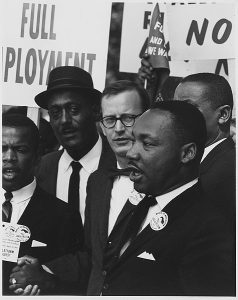Rhetorical Devices
Rhetorical devices offer a way for speakers to arrange language in an artful way so as to make the conversation more engaging and subsequently, more memorable for audience members. Professional and amateur speech writers can employ any number of rhetorical devices to spice up the delivery of a presentation (see Table 7.1).
| Alliteration | Allusion | Anadiplosis | Analogy |
| Anaphora | Anesis | Antimetabole | Antithesis |
| Aposiopesis | Appositio | Assonance | Asyndeton |
| Catachresis | Climax | Conduplicatio | Diacope |
| Distinctio | Enthymeme | Enumeratio | Epanalepsis |
| Epistrophe | Epitheton | Epizeuxis | Eupemismos |
| Exemplum | Expletive | Hyperbole | Hypophora |
| Metaphor | Oxymoron | Paradox | Parallelism |
| Personification | Polysyndeton | Rhetorical Question | Scesis Onomaton |
| Sententia | Simile | Symploce | Synecdoche |
Greek and Roman scholars in the classical period developed and identified most rhetorical devices. Four of the most popular ones used in speeches include alliteration, antithesis, parallel structure, and repetition.
Alliteration
Alliteration occurs when the speaker uses the same letter or sound at the beginning of adjacent or closely connected words. Alliteration appears in everyday uses of language, such as television shows (Mad Men), sporting events (Final Four), company names (Dunkin Donuts), and in famous phrases (home sweet home; right as rain). When used sparingly, alliteration can spice up the language of delivery, such as “We owe it to our city to help the hungry, the homeless, and the helpless among us.” However, speakers can overuse alliteration, turning an otherwise innocuous statement into an exercise in pure silliness: “Nick’s nephew needed new notebooks now.”
Antithesis
The antithesis rhetorical technique juxtaposes two dissimilar or contrasting ideas. Consider President John F. Kennedy’s famous example: “Ask not what your country can do for you—ask what you can do for your country.” Neil Armstrong used an antithesis as he took his first steps on the moon: “That’s one small step for man, one giant leap for mankind.” Consider this technique when trying to draw attention to an important point. Other examples include:
- Many are called, but few are chosen.
- We are taught to speak, but rarely how to listen.
Parallel Structure and Repetition
Parallel structure uses the technique of arranging phrases or clauses of a sentence in parallel form, such as in the following examples:
- Dogs make great pets; they show loyalty, they show obedience, and they show love.
- Our coach told us we should get a lot of sleep, we should eat well, and we should think positively about tonight’s game.

Martin Luther King, Jr. masterfully used parallel structure and combined it with repetition to add engagement to his oratory. Consider his famous I Have a Dream speech:
I have a dream that one day this nation will rise up and live out the true meaning of its creed: “We hold these truths to be self-evident, that all men are created equal.”
I have a dream that one day on the red hills of Georgia, the sons of former slaves and the sons of former slave owners will be able to sit down together at the table of brotherhood.
I have a dream that one day even the state of Mississippi, a state sweltering with the heat of injustice, sweltering with the heat of oppression, will be transformed into an oasis of freedom and justice.
I have a dream that my four little children will one day live in a nation where they will not be judged by the color of their skin but by the content of their character.
I have a dream today!
Repetition occurs when the speaker repeats certain words or phrases to garner emotional effect. Those repeated phrases sound pleasant to the human ear, because they carry with them a certain rhythmic quality, adding emphasis and aiding in memory retention. Repetition as an element of public speaking works differently than it does in written communication. In public speaking, presenters should use repetition because it helps the audience remember key ideas. In written communication, repetition often gets avoided because a reader can review the original reference for memory and comprehension.

